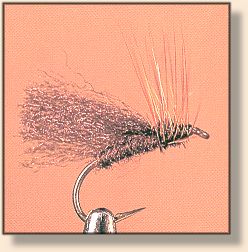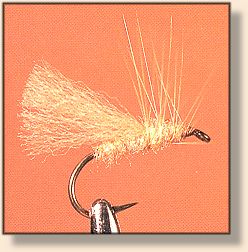Skaddis
By Skip Morris
A true fishing fly - that is, a fly that most fishers will tie and fish rather than
merely discuss and read about and nothing more - must have the following
qualities: It must require, at most, a modest amount of time for the average
tiers to create, it must be constructed of materials relatively easy to obtain,
it must be durable, and it must catch fish at least as well as any other fly
of its type. This is my pragmatic and experience-won definition of a true
fishing fly, and the Skaddis, in both its light and dark versions, fits it.
The wings of most adult-caddis imitations are tied in near the hook's eye, but
I found that this can cause the wing to flare and lose its definition; the short
yarn wing of the Skaddis hasn't the length to spread out, so it stays neatly
bunched in the shape and position of a real caddis's wings. True, this
short yarn wing starts further down the body than do a real caddis's wings,
but that makes no difference because the first bit of the real caddis's wings
are tapered fine and are insignigicant from the trout's perspective. [See
Flies Only for what trout
actually see.] Beyond this, there is nothing unique about my caddis, but
this simple, durable yarn wing that stays neatly in the appropriate shape is
enough.
Materials Skaddis Light (Dark follows below)
Hook: Standard dry fly, sizes 22 to 8 (the hook shown is a
Dai-Riki 305).
Thread: Tan 8/0 or 6/0.
Abdomen: Tan poly dubbing.
Wing: Tan poly yarn.
Hackle: Ginger.
Thorax: Tan poly dubbing.

Materials Skaddis Dark
Hook: Standard dry fly, sizes 22 to 8 (the hook shown is a
Dai-Riki 305).
Thread: Brown 8/0 or 6/0.
Abdomen: Brown poly dubbing.
Wing: Brown poly yarn.
Hackle: Brown.
Thorax: Brown poly dubbing.
Tying Steps:

1. Dub a substantial abdomen from the bend up two-thirds of the shank, and then use
the pinch to tie in a length of poly yarn ahead of the abdomen as shown, (The
thickness of the yarn will depend on the size of the fly; use the photos as a guide.)
|






